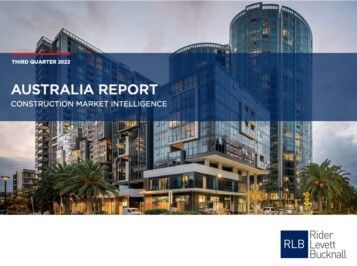Rider Levett Bucknall’s (RLB) 3rd Quarter 2022 Australia Report notes the Australian construction industry is at a pivotal point. Unprecedented construction activity is being seen across all sectors, and across all states and territories seen by decade highs in the value of work yet to be done, commencements, and projects under construction.
Director Domenic Schiafone commented, “This activity surge is being fuelled by post Covid-19 legacies, including government funding of major projects (both state and federally led), delayed commencements of projects put on hold during the lockdown periods and a slowdown in actual output of the industry on the East Coast due to labour shortages and abnormal weather conditions.”
Lack of skilled and unskilled labour impacting costs
“A key impact on cost increases is the lack of skilled and unskilled labour around the country. This has been partly caused by foreign sourced workers leaving Australia in the early lockdown period of Covid-19, the ongoing shortage of labour across all industries within Australia and the rise in number of suitable workers unable to gain access to the country for almost two years due to locked borders. The ongoing industrial shutdowns in China, shipping backlogs, disruption caused by the Russia/Ukraine conflict, and general shipping cost increases all have had significant impacts on the supply as well as the cost of foreign sourced goods,” he added.
One of the key metrics measured, Work Yet to be Done (WYTBD), gives an indication of the building work yet to have been completed within the industry in Australia. The rapid rise over the past five quarters indicates a high level of work started but not completed. This adds pressure on the already stretched workforce to complete the current undertakings and to provide sufficient resources to new projects commencing. With already significant levels of work not being completed, the industry’s current and future capacity to deliver projects on time, on budget and on specification is fundamental for all property development decisions, but these principles are now under stress.
Non-residential approvals up due to government spending
Going forward, approvals in the first six months of 2022 have cooled from the levels achieved in 2021. Total approvals have fallen by 5.0% for the first six months of 2022 when compared to the same period of 2021. Residential approvals fell by 9.5% but non-residential approvals rose by 1.1% due to high levels of government spending in education (up $1B) and health (up $1.5B). The current value of work yet to be done will ensure that volumes of work done during 2022 and 2023 should not fall backwards if these approvals break ground.
Domenic continued, “Given the significant rise in both commencements and work yet to be done for 2022 across the country, strong activity should be seen in 2023.
“Looking forward into the later stages of 2022 and into 2023, we should see the pressure points in supply chains starting to ease as global demands soften with inflationary pressures in all main economies curtailing demand. This easing of demand should allow manufacturing and logistics to get back to ‘normality’. The easing of demand should also see a softening of material prices with the high levels of ‘demand-led price premiums’ reducing,” he said.
Pressure on industry until migration increases
The lack of skilled migration has not allowed those skills to be replaced or additional skills to be added to the workforce when construction levels across the country were rising. There continues to be significant pressure on the industry as the number of workers available is compromised. This will be an ongoing issue until levels of migration increase, which is a current priority for the government.
The construction workforce age demographics are also changing. In 1985, 3% of the workforce were aged over 59, currently it is almost 10%. The converse is seen in the under 24 age group which has fallen from 20% in 1985 to 15% in 2021.
The changing demographics of the workforce are a factor of many differing circumstances. OH&S practices over the past 20 years has made the industry workforce generally healthier and able to work longer due to the reduction in chronic injuries, the retirement age steadily increasing from 65 to 67 and 68 soon, and the changing nature of the workplace, i.e. more offsite modular construction and assembly on site. What will be key in the future is that there are sufficient new starts to the construction industry to replace the aging multiskilled and experienced workforce.
Extreme pressure on contractor tender pricing
The Q3 2022 Australia Report highlights the extreme pressure and volatility on contractor tender pricing which will continue across Australia. Factors that influenced pricing in 2021 have remained prevalent and pressure increased in the first half of 2022 and is predicted to continue into 2023.
Head contractors have reported volatile pricing from the subcontract market, difficulty in pinning down pricing, and sub-contractors being selective in committing to tenders, as many are at capacity or unable to secure the appropriate levels of labour. Supply chain instability, shipping costs and the battle to secure appropriate levels of skilled labour are also all set to remain constant obstacles for the industry as we see out 2022 and move into 2023.
Volatility in tender pricing to continue
Domenic concluded. “Significant surges in tender pricing have been experienced in all states, where escalation uplifts for 2022 are well above the levels forecast in the last publication. This volatility will be felt for the rest of 2022. Suppliers are unable to hold pricing and guarantee availability when tendering. While material price increases have been a risk, contractors and subcontractors historically have navigated and managed, tenders are specifying supply rates for key materials as a condition of tender pricing, resulting in “rise and fall” price adjustment mechanisms being considered and now being negotiated into contracts.”
Slowdown in activity forecast for late 2023
With the levels of approvals dropping and issues surrounding current cost increases, supply chain uncertainties and labour availability, there will be potentially a slowdown of activity in late 2023 to some extent which will be compounded by the rising interest rates from the Reserve Bank of Australia (RBA) and the forecast general slowdown of the economy.
While generally within expected ranges, builder’s margins are moving upwards, and are dependent upon contractors’ appetite for a particular project.
| @ Q3 2022 | 2021 | 2022 (F) | 2023 (F) | 2024 (F) | 2025 (F) |
|---|---|---|---|---|---|
| Adelaide | 7.1 | 4.8 | 3.8 | 3.0 | 3.0 |
| Brisbane | 9.6 | 10.5 | 5.1 | 4.1 | 3.0 |
| Canberra | 3.8 | 5.0 | 4.0 | 3.5 | 3.5 |
| Darwin | 1.2 | 4.0 | 5.0 | 4.0 | 4.0 |
| Gold Coast | 14.5 | 11.5 | 5.5 | 3.0 | 3.0 |
| Melbourne | 3.5 | 8.0 | 4.0 | 3.5 | 3.5 |
| Perth | 13.5 | 9.0 | 5.0 | 4.0 | 3.5 |
| Sydney | 4.1 | 6.9 | 3.9 | 3.5 | 3.5 |
| Townsville | 10.4 | 12.6 | 5.5 | 4.0 | 3.0 |
FURTHER INFORMATION:



